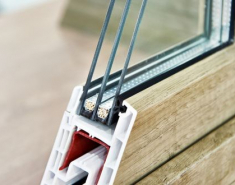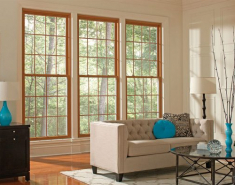Everything You Need to Know About Buying Exterior Doors
When temperatures drop below freezing, homes struggle to hold up in a number of ways. Roofs can get damaged, pipes can burst, windows can crack, toilets can explode, and yes, even doors can freeze. For Hearst Digital Media’s Creative Director, Nick Neubeck, the latter became his reality after the most recent snowstorm in upstate New York actually trapped him inside his cabin. Yes, both his front and back doors froze shut.
Though Nick’s current doors are not Marvin, getting the scoop on quality replacement options was absolutely vital, so naturally, I chatted with Christine Marvin, Director of Corporate Strategy and Design at Marvin Windows and Doors, to learn everything there is to know about doors and how to replace them.
Why Doors Are So Important
“The tightest home you could get from a performance and air-quality perspective is literally a home with no doors or windows,” Christine shared with House Beautiful. By investing in a door that’s made of quality materials and installed professionally and tightly, homeowners decrease the likelihood of these natural elements coming into their home. In keeping drafts and moisture outside, you are not only preventing your doors from freezing shut but also managing the energy efficiency of your home—since less cold air inside means warmer temps—and, therefore, saving money.
“The thing we hear the most from customers, aside from them loving the look of [Marvin] products, is ‘Oh, it’s so nice to see energy savings on a monthly basis.’ There’s a direct correlation [between new doors and saving on bills], without question.”
In case saving you money in the long run and upping the resale value of your home wasn’t enough of a reason to buy a new door, safety is an added bonus. Because if air and water can get in, so can intruders, animals, and other critters.
When You Need a New Door
As with everything used on a daily basis, doors begin to weather with usage. High-quality doors, though, should last upwards of 25 years, Christine says. That’s not to say components of the door won’t need to be replaced before that time comes—like weatherstripping, for instance, but when maintained properly and preserved, doors will last at least a couple of decades.
Maintain Your Door With These Steps
Keep an eye on the weatherstripping, and if it’s not effective, contact a dealer to have it replaced.
Check to make sure all hardware operates properly, including locks, hinges, etc.
Ensure all screws are securely tightened.
Remove dirt, sand, and dust from hinges, sills, and tracks.
Look Out for These Signs
If your door experiences any of the following, it’s likely time to replace it:
Drafts
Difficulty opening and closing
Trouble locking
How to Choose a Door
Christine suggests contacting your local dealer before choosing the material for your door to ensure you are picking the best for the climate in which you live. While Marvin doors are designed specifically to withstand both extreme heat and extreme cold, there are pieces of the customization process that may change, depending on your region.
Glass packages, for example, are designed for where you live, because a glass door in colder climates will be much different than one designed for a home in a hurricane zone. Additionally, depending on where you live, your sill (AKA the threshold of your doorway) will differ, but a high-performance sill is particularly important for regions with a lot of rain, frost, or fluctuations in temperature. (In other words, this might be something Nick will want to consider when he replaces his current door.)
Know Which Type Of Door Is Right For You
Wood — can endure drastic temperature changes and provides exceptional insulation
Aluminum — maintains its color and overall integrity for a long time and offers amazing insulation, particularly when married with wood
Pultruded fiberglass — maintains shape in harsh climates, even when it’s regularly exposed to temperature variation, wind, rain, or snow
Source: https://bit.ly/2RegqqJ









